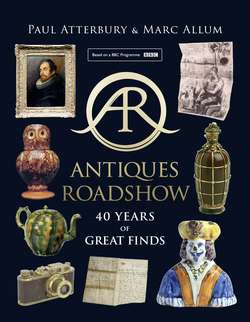Читать книгу Antiques Roadshow: 40 Years of Great Finds - Paul Atterbury, Paul Atterbury - Страница 23
MUGHAL BRACELETS
ОглавлениеOver the years, many items brought to the Roadshow have offered rare insights into the great days of the British Empire, especially objects from India. From the eighteenth century onwards, many British families spent their lives working and living in India, as merchants, diplomats, civil servants and in the military, and when they returned to Britain they often brought with them treasures acquired during their period of service.
In 1995, an unexpected example was brought to John Benjamin, at Peebles, in the shape of a pair of richly enamelled gold bracelets dating from the middle of the nineteenth century. The family story was that the owner’s great-grandparents had lived in India while her great-grandfather worked as a civil engineer. As was often the case, the family had come into contact with one of the local Indian princes, and the bracelets had been a gift from the prince to her great-grandmother.
This type of bracelet, worn on the ankle or upper arm, was traditionally associated with a wedding and could have been part of a bride’s dowry. In this case, they took the form of confronting serpents, made from twenty-two carat gold, enriched with patterns of birds and flowers in red and blue enamel and studded with table-cut diamonds. Such jewels are associated with the Mughal period in Indian history.
Founded in 1526, the Mughal dynasty came to dominate many parts of India and had a long-lasting impact upon art, architecture, design and decoration until it ended with the death of Emperor Bahadur Shah in 1858. Jewellery was particularly important, with the wealth and status of both men and women reflected in the amount of extravagant jewels worn all over the body. In styles that bring together Mughal craftsmanship and Middle Eastern decoration, the jewels feature gold and silver metalwork in complex patterns, enriched with colourful enamelling and inset with diamonds and other gems. Mughal jewellery was designed to decorate the whole body, from the turban to the toe, and so the range included turban pins and ornaments, hair-pieces,ear-rings, nose rings, necklaces, bracelets, finger and toe rings, hand ornaments, amulets, belts, hip chains and much else besides. The actual weight of jewels worn and displayed underlined the wearer’s status. The great diversity of surviving Mughal jewellery reveals both its importance and the huge number of workshops that must have been kept busy making it all over several hundred years.
In 1995, John Benjamin valued the bracelets for £10,000 to £15,000. Today, that price would probably have increased considerably, thanks to the great interest now shown by modern Indians in their history and culture.
